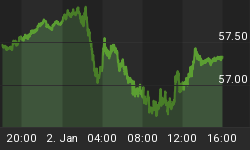Is this the move into the 9 month cycle low?
Dear Speculators,
One question I get from my readers is "Jay, there are so many cycles in the market, which one(s) should I follow?" Well, the answer is quite simple. As few as possible. If you think about it, you have 10, 20, 40 week cycles, 30 day and 105 day trading cycles, Fibonacci time cycles, presidential election cycles, 4 year cycles, (and I could go on). There's no way one person could follow them all and have any meaningful trading results.
I think one of the most important things to consider is that a cycle is simply another type of indicator. And no indicator works all the time. Let me repeat that, no indicator works all the time. Otherwise we'd all be millionaires. So while cycles may be good for establishing a big picture and overall outlook for the market (which is how we look at them below), they're not a precise enough timing indicator to be entering short term trades.
Looking closer at the 10/20/40 week - noting each time frame is a harmonic of the other - we are now in the crux of a decline across all 3. Sure the market may continue higher here, but it's not likely to. And trading is all about likelihood and probabilities.
Of course, if you have any additional questions, please feel free to email me at jay@stockbarometer.com.
Dynamic Trading Signals are based on a series of Oscillators tuned to the short and intermediate term movement of the market. Our goal is to be in the market at all times and switch from bearish to bullish positions in line with the markets movements (except for the Options service, which is subject to greater volatility and time decay). Periodically we will go to cash and await the next system trade.
DYNAMIC TRADING OSCILLATOR

10/20/40 WEEK CYCLE
The following chart shows our 10/20/40 week cycles. The 40 week is also referred to as the 9-month cycle. Cycles are not short term tools for determining precise entry and exit points, they're primarily used for intermediate or longer term positioning and forecasting.

INVESTOR'S INTELLIGENCE BULL BEAR SPREAD
Each week, Investor's Intelligence polls a number of newsletter writers. The poll results in a number of bullish advisors and a number of bearish advisors. The difference between those two numbers produces the following chart. It's believed, that when a majority of newsletter writers (like us) are bullish, that the market is near a top, and vice versa. The direction of this line is as critical as the level.

EQUITY INDEX OPTION VOLUME RATIO
The market is all about risk, and there are two primary classes of participants in the market, the individual investors and the institutions. Individuals primarily trade equity options and institutions primarily trade index options. So the relationship between the two gives us an idea of how much risk the individual is willing to take on. At tops, the individual tends to take on too much risk, making this indicator rise. At bottoms, the individual is usually washed out of the market, making this indicator fall.

QQQQ v. SPY RELATIVE STRENGTH
Risk tells us a lot about the market. This indicator looks at risk from another perspective. When market participants overall increase their willingness to take on risk, it's bullish for the market. That risk shift is shown on the above chart as a shift in relative strength from the Nasdaq to the NYSE. Note when we refer to Nasdaq, we're primarily looking at the QQQQ - since that's the focus of our service. And when we say NYSE, we look at the SPY.

MONEY FLOW
This indicator looks at the flow of money in and out of various investment vehicles. For the most part, when money flow reaches an extreme, in either buying or selling, the market is at a top or a bottom, respectively.

NDX CHART

In summary:
Dynamic Trading remains on its current SELL SIGNAL.
Our expectations are for this market to initiate an intermediate term move lower into the end of November. Friday's selling should continue into Monday and Tuesday will be evaluated as a potential turnaround day. We'll be looking at it the same way.
Best regards and good trading!
















